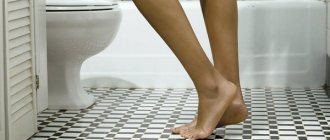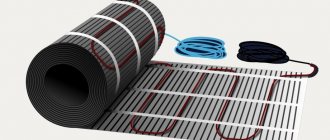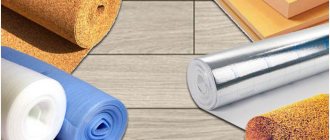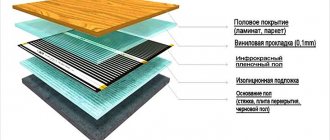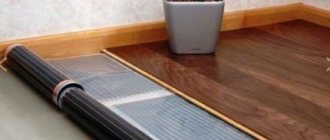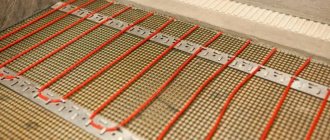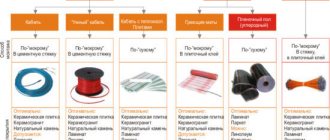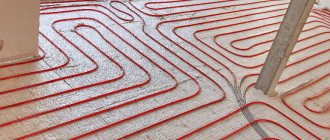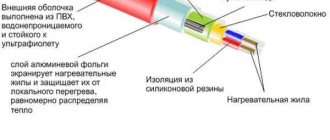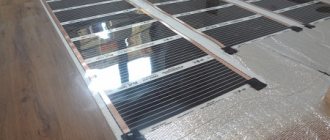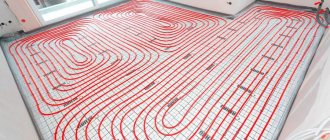Substrate for film infrared heated floor
If you install infrared heated floors, you can be sure that heat loss from the heating system will decrease. The substrate is laid on a sweat film layer with infrared resistors. You can use magnesite boards or fiberboard as a substrate. You need to lay the underlay directly on the screed, on which it would be a good idea to first lay aluminum foil.
The insulating layer can be in the form of penofol, i.e. metallized polymer film. It also reflects heat. In its manufacture, polyethylene foam is used, covered on one side with a thin metal film.
Flexibility, elasticity, and environmental friendliness are the three main characteristics of this material.
Here are the functions it should perform:
- Convection;
- Radiation;
- Thermal conductivity.
If you use a laminate underlay for heated floors, then it will be able to reflect up to ninety-seven percent of thermal radiation, no matter what kind of heated floor device you use and no matter the principle of its operation. This will significantly reduce energy costs.
It’s clear that if you want the film heated floor to work properly, you must install it in strict accordance with the instructions.
This primarily concerns the substrate:
- The model for infrared heated floors can be made from HDL sheets or magnesite board. It must be laid directly on the screed, previously covered with a sheet of aluminum foil.
- If the substrate is presented in the form of a polymer metallized film, installation is carried out on a film with IR resistors. The main thing is to lay it with the reflective side up. This material is flexible, thin, elastic.
- The insulation is laid over the entire area in a continuous mass. The individual panels are joined end-to-end. The seams must be taped with adhesive tape or tape. The material can even be glued if necessary;
- The heating elements are located on top of the reflective coating.
I think that after reading this article, you are convinced of the need to use a substrate when creating a new heating system. It is the substrate that will make it possible to take advantage of all the benefits of a heated floor system. We recommend that you familiarize yourself with the material on installing heated floors.
Different ways to install heated floors
There are three ways to lay heated floors under laminate with your own hands:
- into the screed;
- on wooden sheathing;
- directly under the finishing coat.
We will consider each method separately.
Into the screed
An option for laying a water-heated floor in a screed (a laminate is placed on top).
A water circuit, an electrical wire in mats and a single wire in coils can be placed in concrete. The best option is when the heating element is surrounded on all sides by a concrete screed (including from below). Therefore, work must be performed according to one of the following algorithms:
- insulation, waterproofing, 30 mm concrete, heating element, 30 mm concrete;
- insulation, waterproofing, metal mesh with a heating element attached to it, 70 mm of concrete.
Please note that in the second case the mesh will rise a little and the screed will flow under it, so you cannot make a filling layer less than 70 mm. There must be at least 50 mm of screed above the heating element. There are four layouts for pipes and single cables (three types of snake and snail). In this case, you need to observe a step that should not be more than 300 mm. Be sure to place underlayment underneath the laminate to keep the floor quiet.
Between the sheathing
For this type of installation, only low-temperature water circuit pipes and a single electrical wire are suitable. The lathing on the floor is made from boards. Their thickness should be equal to the sum of the cross-section of the pipe or cable and the thickness of Penofol.
The boards are attached to the floor with dowels. There should be a distance of 20 mm between them. Gaps are left at the ends so that the warm floor can be spread with a snake. Penofol is placed on top of the boards so that it fits into the grooves for the heating elements. Penofol is attached with a stapler. Then a pipe or cable is inserted into the prepared seats. Laminate is placed on top of the sheathing. In the video you can see in more detail how to lay a heated floor under a laminate using lathing:
Directly under the laminate
Only infrared films are suitable for this work. First, a soft substrate with a reflective surface is spread on the floor. They say that you need to use a special (naturally expensive) material, but in fact you can also use ordinary foamed polyethylene with an aluminum coating. An infrared film is spread on top of the substrate. It is cut into the required lengths between the black stripes, and the contacts are insulated with bitumen stickers, which are included in the kit.
Then the strips are connected to each other by wires that are connected to the thermostat. The wires are attached to the films with clamps, which will need to be insulated with the same bitumen overlays. A temperature sensor is installed on one of the black stripes at the bottom of the film. Grooves for the sensor, contacts and wires are cut out in Penofol. Then the laid films are fixed with tape to each other and glued to polyethylene foam. The grooves with wires are also glued. Ordinary polyethylene is spread on top of the IR film, on which the laminate is already placed. Watch the video, everything is shown and explained in detail:
IR heated floor under laminate - subtleties of technology
Installation of an infrared floor system, although simple, requires attention and has certain features. Still, the work is carried out using the home’s power supply system, so mistakes should not be made here. Otherwise, the floors will either not work or simply become dangerous for the home owner.
Is it possible to lay laminate flooring on a heated floor?
Even before installation begins, a complete and accurate floor laying diagram is drawn up, on which the IR mats themselves and all system control elements are indicated. The installation locations of thermostats, temperature sensors and other equipment must also be marked.
The thermostat is usually installed on the wall, and in order to hide all the wires, it is recommended to cut a narrow groove into it, into which communications will be laid. Thus, they will not be conspicuous, because after laying the wires the cavity is sealed. In this case, the wires must be placed in a corrugated tube.
Heated floor thermostat
Also, first on paper, and then on the floor itself, a diagram of the location of all infrared films is drawn. This procedure, in addition to convenience during subsequent installation, will also help to accurately calculate the consumption of all materials - wires, films, etc. The connection points of all wires are also marked on the diagram.
Nuances when working with IR film that should be taken into account before installation:
- the film is cut only along clearly marked lines;
- in order to have fewer joints between individual sections, the film should be rolled out along the long wall of the room;
- there must be a gap between the wall and the first line of the film - its width cannot be less than 25 cm;
- designations of the places where the furniture will be placed are immediately entered into the diagram (bedside tables, cabinets, sofas, etc.) - the film is not placed under them, which will reduce material consumption, and in the future the floor in this place will not overheat, which means the system will not burn out;
- each strip of IR film is placed at a distance of 5 cm from the adjacent one;
- the neutral and phase wires should not intersect when connecting, so they are connected only on opposite sides of the film;
- the temperature sensor should be located in the coolest place in the room so that it is in the middle of one IR element;
- the length of one IR strip cannot be more than 8 m;
- a suitable place for the thermostat is 15 cm from the floor level;
- Individual strips of film cannot be laid overlapping or on top of each other.
Rules for installing substrates
It is recommended to install the elements on the most even surfaces; you should not rely too much on manufacturers’ advertising statements about high strength that allows installation on uneven surfaces. If the substrates are made of materials containing wood, then waterproofing must be done. Except in cases where water-heated floors are installed on wooden floors.
Installation of a polystyrene system using mounting mats
The presence of aluminum foil is an important advantage. It not only significantly improves heat saving performance, but also serves as another waterproof barrier. Special substrates not only improve the quality and efficiency of heating systems, but also significantly reduce the installation time. You should not save on their purchase; taking into account all factors, the money invested will not only pay off, but will also bring considerable direct profit.
Warm floor: installation stages
Foil reflectors
A foil reflector and a laminate backing for a heated floor are two different things, so don’t confuse them. They are often made from the same material - polyethylene foam. But the functions are completely different.
The foil insulation should reflect heat, and the substrate, on the contrary, should contain it.
The parameters are all very similar. It follows that aluminum and metallized propylene film are equally suitable for heat-reflecting underfloor heating.
The goal here is not to heat the concrete screed below, saving energy.
This is far from clear. The heat from the heating element, pipe or electrical cable, goes up in a funnel at an angle of 45 degrees. These flows gradually decline towards the horizon, so heat is transferred downwards at the molecular level.
It is not aluminum or metal that creates a thermal barrier; they are good conductors of heat and are not capable of this. Their role is different. And a barrier to heat loss is created by foamed polyethylene, which is located at the base.
Helpful information. This happens because the pores of the polyethylene are filled with air. Due to this, a thermal barrier is created.
Why do you need foil then? What is her role? It reflects infrared rays. This insulation increases the heating effect by up to 70%. The percentage of increase depends on many conditions - air humidity, temperature, even the size of the heated room. Thus, the presence of foil is very justified; it has its own important role when laying under laminate.
Allow me advice. For heated floors with IPO, it is better to use a substrate with aluminum foil. Then all the infrared rays will go to the room. For other designs of heating systems, this does not matter, you can use a substrate with aluminum, or with a metallized propylene film.
The laying of substrates under the laminate and under the heated floor contour is the same. This insulation is laid either overlapping or butt to butt. These are two different installation methods, the choice depends on the thickness of the insulation.
You cannot lay a thick layer with an overlap; you must use another method. The thickness of foamed polyethylene with a layer of foil can vary greatly - from 2 millimeters to twenty. Depending on this, on this thickness, the installation method is selected.
If the foil foamed polyethylene has a thickness of no more than 6mm, it can be safely laid overlapping, that is, launched on top of each other. In this case, the joints must be secured with tape to ensure the strength of the flooring.
Unacceptable. so that it moves when the pipes and brackets are installed. Usually a thin reflector is placed on the floor under the laminate.
When thick, you get a soft cushion that will have a negative effect on the top screed. The screed may become deformed and crack.
If additional insulation is necessary, additional sheets of extruded polystyrene foam are placed under the thin insulation. It also comes in different thicknesses. It depends on how much thermal insulation power is needed.
Allow me some advice. It is necessary to lay a water barrier under the reflector if you are not sure that there is waterproofing on the screed or concrete floor. Thick cellophane can successfully play the role of this barrier; it just needs to be unfolded.
Why use a substrate?
For a water heating system, a laminate with certain characteristics is selected. It is more durable, but at the same time elastic. When heated, it expands, and when cooled, it restores its original shape without deforming or drying out.
The slats can withstand temperatures of 40 0C well, despite the fact that the maximum floor temperature is no more than 25 0C. They are resistant to moisture, but its amount must be minimized.
An underlayment must be placed under the laminated flooring. For water underfloor heating, its thickness should not be more than 3 mm. Why is an additional coating installed under the laminate?
- Laminate cladding is laid on a flat screed surface or self-leveling floor, but, unfortunately, it is not always possible to create an ideal coating. The underlay is designed to soften minor unevenness of the rough foundation.
- A wooden covering laid on a concrete screed creaks a lot. The additional layer plays the role of sound insulation.
- The slats are able to move; expand and contract. Experts say that the canvas can expand by 10 mm per season. This is due to temperature changes. At the same time, a large load is placed on the connecting locks. They may become unusable. The backing will reduce the load on the locks.
- When installing underfloor heating, condensation forms on the cladding surface. An additional protective layer protects the cladding from moisture.
We recommend: How to lay polystyrene foam for heated floors?
Laminate, like parquet, is a material that retains heat for a long time, so additional thermal insulation is not installed on the cladding. The task of floor heating installers is to create a system that would effectively heat the floor surface. With an additional thermal insulation layer, heating the flooring will require a lot of energy, so insulation is abandoned.
The underlay for a heated floor should be thin and allow air to pass through well. Pay attention to resistance to moisture and high temperature. Choose insulation that is inert to the chemicals of the concrete solution or mixture for the self-leveling floor. An important factor is the bactericidal properties of the material so that fungus and mold do not form in it.
Natural and synthetic insulation is used as a protective layer for lamellas. The most effective natural coverings are cork and pine needles. Among synthetic ones, it is recommended to use polyethylene foam, polystyrene foam, and combined products. Which underlay is most suitable for additional protection of laminate flooring during underfloor heating?
General floor insulation technology
First, the base is prepared. All existing unevenness on the floor should be eliminated: ridges, holes and cracks should be smoothed out, filled with mortar and puttied. The next stage is waterproofing. The surface is covered with plastic film so that the edges overlap. Tape is applied to the seams. The waterproofing layer is very important: it protects the wooden elements from moisture.
If a wooden floor is insulated, then logs are laid, and thermal insulation material (expanded clay, mineral wool, polystyrene) is placed in the space between them. Then, to level the surface, boards and substrates made from materials produced in sheets, for example, plywood, are used.
If the floor is uneven, you can level it using a concrete screed or self-leveling mixture. This floor mixture is prepared in accordance with the instructions in a container of suitable size. Then it must be spread over the surface using a spatula.
Purpose of backing material
The backing prevents the formation of play between the panels
Laminate has been used in combination with warm water floors for quite a long time; it is easy to install, has a relatively inexpensive price and a presentable appearance.
When constructing it, the presence of a substrate is required, which will avoid the formation of backlashes when connecting boards and various sounds in the floor.
The thickness of the substrate varies from 2 mm to 5 cm; its main property is thermal conductivity. It will also help:
- protect panels from harmful effects that may occur during the interaction of concrete and fiberboard;
- prevent harmful emissions from the laminate when heated;
- insulate the coating;
- soften the load;
- equalize elevation differences;
- extend the life of the laminate.
Special mention should be made about rolled polyethylene. Experts consider this material the most suitable option of all those presented on the construction market.
It goes well with concrete and cement screeds, is able to withstand various impacts and delays the appearance of microbes.
READ MORE: How to store laminate, winter storage conditions in packaging
When choosing a substrate for a laminate flooring for a warm water floor, first of all, you need to study the surface, determine the degree of moisture in the room and its size. This must be done to understand the direction of laying the material.
It is best to make the choice with a specialist who will help with practical advice. At the same time, you will need to add polyethylene or foil to the substrate.
If the floor is level, there is no need for a thick underlay
If the owner decides to do all the work himself, it is necessary to carefully study the technology for performing the work.
A thin underlay of 2 mm thickness is suitable for a flat floor base. If there are small irregularities, it is better to use material 3 mm wide.
The backing prevents the formation of play between the panels
What kind of substrate is laid under a heated floor?
Magnesite or fiberboard sheets are traditionally used for this purpose. Another material that has proven itself well is Penofol. Thanks to the use of Penofol, the thickness of the reflective thermal insulation film for IR floors can be minimized. The advantage of Penofol is that it is both an insulating and reflective material and prevents the spread of:
- Warmth.
- Convection of air flows.
- Radiation.
When choosing a substrate, it is necessary to focus not only on economic considerations, but also on the actual technical features of the room.
What additional thermal insulation is needed under the IR floor?
The thermal insulation used when laying film heated floors is designed to achieve two goals:
- Prevent the entry of cold air from outside the room (basement, basement, etc.).
- Prevent free movement of heated air from the building.
When choosing an insulating material, you should follow the recommendations of the manufacturers of heated floors. Manufacturers believe that better thermal insulation is made of polyethylene foam with a reflective coating of metallized Mylar film.
It is strictly not recommended to lay material using aluminum foil under heated floors. As recent studies have shown, the use of foil insulation leads to overheating of the infrared heating system and failure of individual elements.
The effectiveness of IR floors is not affected by the type of insulation you plan to use. Therefore, the material can be almost any, based on the wishes and capabilities of the customer. The only limitation is the installation of thermal insulation with aluminum foil.
For thermal insulation, you need to use a material that can stop possible heat loss, protect the floors from overheating and prevent cold from entering the heated room.
The heating system using IR elements effectively heats the room. The choice of substrate and thermal insulation plays a significant role in ensuring performance and effectiveness. When selecting the necessary material, you need to focus on the opinion of the manufacturer, who provides comprehensive recommendations in the operating instructions.
Calculation of power and temperature of a warm water floor
Combined material
The water-heated floor is laid in a concrete screed. Condensation may form on it. To prevent moisture from getting on the laminate, the screed is covered with thin polyethylene. Next, lay the substrate. Manufacturers suggest using a combined material that consists of polyethylene film and expanded polystyrene.
Another type of substrate for linoleum is foil polystyrene foam. The foil will serve as a reflective screen. It promotes directed heat distribution to the floor surface.
We recommend: How to install a heated film floor?
For laminate flooring that is laid on a heated water floor, choose foil with lavsan fabric. It is recommended to place it on a rough surface to prevent heat loss associated with heating the foundation. In this case, the cladding substrate can be used without a reflective screen.
To retain the heat that comes from the water circuit to the floor surface, it is necessary to use insulating material. A substrate is chosen for the laminate. The best coating is bitumen-cork, rubber-cork material, and expanded polystyrene. Combined insulation based on polystyrene foam is effective. It is not recommended to use laminate without a backing.
YouTube responded with an error: The request cannot be completed because you have exceeded your quota.
- Related Posts
- How to install Grand Meyer underfloor heating?
- How to install underfloor heating on a wooden floor?
- What should be the height of the heated floor?
- How to lay a heated floor without screed?
- How to lay polystyrene foam for heated floors?
- How to install Energy heated floors?
Infrared floors
Here we can no longer consider the systems as a classic version. Despite the similar use of the underlay for underfloor heating components, it has a slightly different purpose. After all, infrared film and heating cable have different roles in heat sources. The cable acts directly on the floor, from which the air in the room is heated. Infrared film increases the temperature of the selected floor covering, as well as surrounding objects, which can be furniture, walls, etc. And already from these elements the air in the room begins to warm up.
A waterproofing layer is laid on the existing floor base, on top of which is heat-insulating reflective material. The latter is the substrate for the heated floor system. All that remains is to lay the infrared film. Sheets of film are connected to each other in certain places, after which they are connected to the electrical network.
The substrate of an infrared heated floor has a very important feature - it cannot be foil-coated. Aluminum foil cannot be used as a reflective element. This is fully compatible with the requirements for safe operation of the heating system. If damage occurs to individual sections of the heating elements, a short circuit to the laid substrate may occur.
The underlay for infrared heated floors performs two main functions:
- Thermal insulation.
- Reflects infrared radiation that is directed toward the floor rather than into the room.
The low cost of the substrate allows it to be purchased everywhere and used without fail. In addition, there is a saving of about 30% of the incoming heat. More precisely, losses during the operation of infrared heated floors are reduced.
The main material for the substrate in this case is polymers or foamed polystyrene. The reflective material is metallized lavsan. You can purchase it in the same place where various underfloor heating systems are offered for sale.
At first glance, this requirement is not mandatory when installing infrared heated floors. But the efficiency of the system, as well as the safety of heating in the room, increases significantly. Even a 30% reduction in heat loss for any system will be noticeable and significant
It is very important to fully adhere to the technology during the installation process and follow it from the very beginning to the end.
Installation
You should start by preparing the foundation. There should be no defects, unevenness, debris, or other similar difficulties. The panels themselves are brought into the room a week before installation. They gradually warm up, obtaining the desired level of acclimatization. That is, they are prepared for installation.
Fastening with glue means gradually filling the area from the center of the room. The surface there is 100% dry. As it fills, the heating will dry out the corners. The method always works.
The adhesive mixture should be applied to the base and slabs. Installation is carried out parallel to long walls. First, one half of the room is filled. The interlocking panels fit easily even without a cork floor heating system.
To improve the final quality, a polyurethane backing is implied. The process starts from windows to doors. The parts are connected at an angle of 30 degrees. Detailed instructions are included in the kit. Tapping with a rubber hammer is allowed.
We recommend: Which underlay to use for heated floors?
There should be a gap along the walls. The distance is no more than 1 cm. The ideal option is 8 mm. After heating/humidity, slight deformation will occur. The remaining space is just about to be filled. It is this choice that is correct and provides for reliable fixation.
Laminate selection criteria
Having decided to make an infrared heated floor in an apartment with a finishing coating - laminate, the question arises - what type of lamellas is suitable for such a system. If you lay inappropriate parquet, when heated it will deform, may release harmful substances, and will conduct heat poorly.
The product must:
have a special marking - “snake”, which indicates the possibility of using it with an infrared heating system;
- have good thermal conductivity - the thermal resistance coefficient should be from 0.05 to 0.10 m2 x °K/W;
- have a thickness of 8 - 9 cm;
- do not emit formaldehyde when heated to 30 degrees, that is, permissible emission class E1 or E0;
- to be wear-resistant - better than 32 or 33 wear resistance classes.
All this information can be found on the packaging.
What types of substrates exist?
Today, the manufacturer offers a large selection of different linings for fiberboard flooring, which differ in technical characteristics and operating conditions. Each copy is designed for specific conditions. During the renovation period, it is necessary to take into account all aspects related to the floor covering.
Cork backing
It contains compressed cork oak chips.
Such a material can provide a good level of sound insulation and maintain temperature, but does not tolerate moisture, so its use is possible in dry rooms without waterproofing.
It can be used in panel houses, but it is not recommended to use it in rooms with newly made screeds and above bathrooms.
The cork backing must be laid on a prepared, flat surface to avoid deformation of the laminate.
Polyethylene (isolon)
One of the cheapest artificial types of substrate, which has low cost and reliable protection from moisture. Its thickness is 2-3 mm, but under the influence of pressure the size of polyethylene decreases, while making up for unevenness in the floor.
For rooms with high humidity, this material is ideal. It protects the laminate from destruction; when using it, you must make an overlap of at least 25 mm.
Made from polystyrene foam
Expanded polystyrene protects well from moisture and has excellent shock absorption
READ MORE: Heated floor sensor: how to connect a thermostat
This material is widely used as a substrate for laminate flooring.
Characteristics such as rigidity and lack of leveling ability allow the use of polystyrene foam on a completely flat floor.
One layer of it can protect the room from moisture and will perfectly act as a thermal insulator.
When using this material, it is imperative to observe fire safety, since it emits harmful substances when burned.
Tuplex
The elite tuplex backing has excellent leveling properties, sound insulation and excellent heat retention. It is non-toxic, will serve for a long time and retain its properties.
Cork backing
It contains compressed cork oak chips.
Made from polystyrene foam
Expanded polystyrene protects well from moisture and has excellent shock absorption
